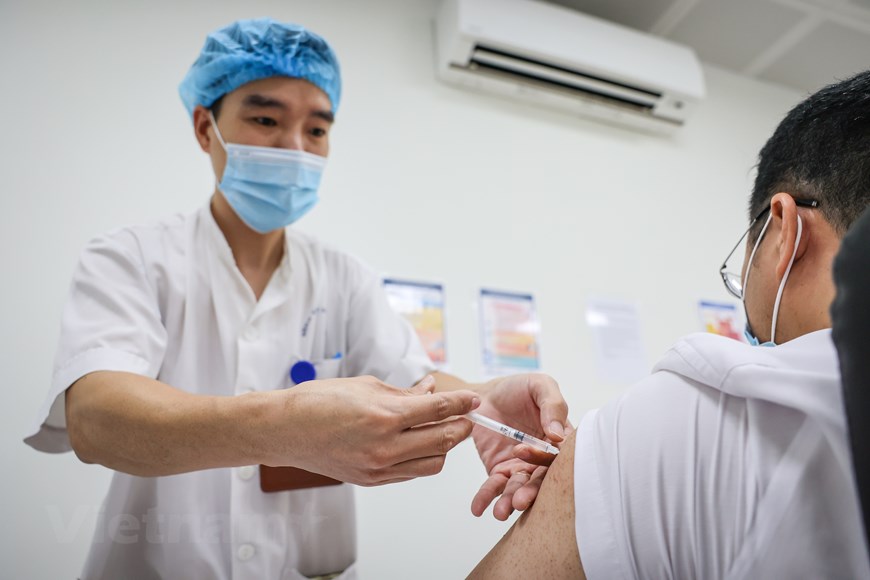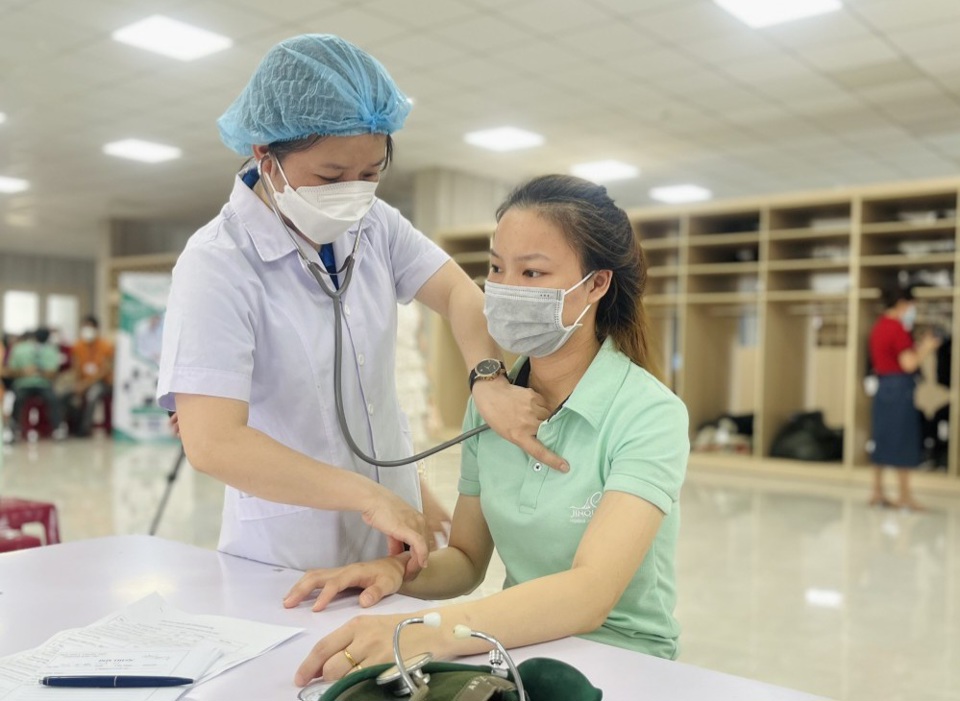Details of SARS-CoV-2 infection control measures in medical establishments in Vietnam
What are the details of SARS-CoV-2 infection control measures in medical establishments in Vietnam? – Huynh Chuong (Ninh Thuan)

Details of SARS-CoV-2 infection control measures in medical establishments in Vietnam (Internet image)
The Ministry of Health of Vietnam issued Decision 2609/QD-BYT dated June 20, 2023, on guidelines for the prevention and control of COVID-19 infection in medical examination and treatment establishments, in which measures are taken to prevent and control SARS-CoV-2 infection in medical establishments.
Details of COVID-19 infection control measures in medical establishments in Vietnam
According to Guidelines issued together with Decision 2609/QD-BYT, measures to control COVID-19 infection in medical examination and treatment establishments in Vietnam are implemented as follows:
(1) Organize early detection and timely isolation of people with or suspected of having COVID-19.
- Patients showing signs of COVID-19 infection (cough, fever) upon arrival at medical examination and treatment establishments are instructed to be examined at the infectious disease clinic; Emergency patients are instructed to be examined at the reception area of the Emergency Department.
- Performing a rapid diagnostic test for COVID-19. Those who are positive for COVID-19 and need to be hospitalized are isolated, treated in the emergency department (if the patient is in an emergency condition), or isolated and treated according to specialties.
- In clinical departments, if a patient is found to have COVID-19, the patient will be transferred to the isolation room of the department for isolation and treatment.
- Room for examination of infectious and respiratory diseases; The reception area (Emergency department) and isolation rooms in clinical departments must ensure ventilation requirements and always have the required isolation conditions and establishments available.
- Medical staff who directly examine people with or suspected of having COVID-19 should wear medical masks and gloves and strictly follow hand hygiene regulations.
(2) Implement standard precautions in conjunction with the route of transmission.
Perform standard precautions in combination with airborne, contact, and droplet precautions depending on the clinical situation when examining, treating, and caring for someone with or suspected of having COVID-19.
Standard precautions: Apply to all patients. Pay attention to instruct patients, family members, and visitors to cover their nose and mouth when coughing, sneezing, wash hands immediately after contact with respiratory secretions, and discard used masks, tissues/papers in the right places as prescribed.
- Prevention based on the route of transmission:
+ Airborne Precautions: Apply when performing aerosol-generating procedures or during surgery in people with or suspected of having COVID-19. Healthcare workers need to wear N95 masks.
Droplet Precautions and Contact Precautions: Applicable in most clinical situations.
+ The patient is placed in an isolation room or shares a room with other COVID-19 patients.
+ Medical staff wear medical masks and gloves when examining and caring for COVID-19 patients. Wear a disposable paper gown when performing procedures that pose a risk of splashing blood/body fluids. Strictly observe the regulations on hand hygiene.
+ Patients and family members always wear medical masks, especially when moving outside the isolation area.
(3) Ensure environmental ventilation in the patient care area.
- The isolation chambers need to ensure negative pressure ventilation. If negative pressure ventilation is not available, apply natural ventilation in combination with mechanical ventilation. Ensure an air exchange frequency ≥12 times/hour. Airflow exiting the isolation chamber should be directed to a low-traffic area.
- Enhance natural ventilation in all patient care areas.
(4) Use personal protective equipment.
- All medical staff, when performing professional activities taking care of patients with COVID-19, strictly follow the steps of selection, use, and removal of personal protective equipment to ensure safety and effectiveness according to the risk of infection.
- Encourage patients and their family members to wear masks when entering medical examination and treatment establishments.
- Not use personal protective equipment that does not meet the prescribed standards. Not reuse personal protective equipment in any form.
- Discard personal protective equipment in the right place.
(5) Strengthen hand hygiene practices.
- Medical examination and treatment establishments need to strengthen hand hygiene in accordance with "Guidelines for hand hygiene in medical examination and treatment establishments", issued under Decision 3916/QD-BYT dated August 28, 2017 of the Ministry of Health of Vietnam.
- Notable point:
+ Fully equipped with means of hand hygiene, especially alcohol-based antiseptic solution, in all examination areas, wards, places where surgery and procedures are performed.
+ Equip with alcohol-based hand sanitizer for family members and visitors to clean their hands when needed.
+ Strengthen supervision of compliance with hand hygiene practices among healthcare workers, patients, and visitors, especially in high-risk areas and isolated areas.
(6) Sanitize and disinfect surface environments, means of transport, and patient care.
- It is necessary to clean and disinfect surface environments and vehicles for transporting and taking care of patients according to "Guidelines for surface environmental hygiene in medical examination and treatment establishments" issued under Decision 3916/QD-BYT dated August 28, 2017 of the Ministry of Health of Vietnam.
- The following points should be noted:
+ Staff performing cleaning and disinfection of the surface environment (medical staff and industrial hygienists)
need to be trained in regulations and procedures for environmental cleaning and disinfection when working at the establishment.
+ Medical examination and treatment establishments need to be fully equipped with means, tools, chemicals, supplies, and personal protective equipment for cleaning and disinfecting environmental surfaces, transportation, and patient care.
+ Strengthen supervision of the quality of cleaning and disinfection of surfaces frequently in contact with hands, surfaces in isolation areas for COVID-19 patients.
(7) Prevent infection with SARS-CoV-2 in some special situations.
- Surgery for patients with COVID-19:
+ Ensure requirements for ventilation in the operating room.
+ Limit medical staff to the operating room.
+ Members of the surgical team wear N95 masks and sterile gowns that are impervious to blood and fluids.
- Protection of patients at high risk of infection (immunocompromised patients, dialysis, cancer...):
+ Arrange patients according to their own areas, depending on their actual conditions. Remind and limit the patient's movement and contact during treatment.
+ Instruct and reminding patients, caregivers, and visitors to practice hand hygiene, respiratory hygiene when coughing, cleaning personal vehicles, and wearing medical masks.
+ Advise patients on vaccination against COVID-19 according to the vaccination schedule and current guidelines on vaccination against COVID-19 of the Ministry of Health.
+ Be alert, detect early signs of suspected COVID-19 infection, and promptly diagnose and treat COVID-19.
+ Healthcare workers strictly follow the practice of "standard precautions and transmission precautions" when caring for COVID-19 patients.
(8) Get vaccinated against COVID-19.
+ Health workers should be vaccinated against COVID-19 according to the current guidelines on vaccination against COVID-19 of the Ministry of Health.
(9) Strengthen training and monitoring of compliance with preventive practices among healthcare workers.
- Every year, medical examination and treatment establishments need to organize re-training for medical staff (including new employees and interns) on infection control practices, with an emphasis on practices for the prevention of endemic infectious diseases.
- Monthly, conduct inspections and supervision for compliance with infection prevention practices among healthcare workers and promptly remedy any post-surveillance points.
03 ways of transmission of COVID-19 under latest research
Current evidence suggests that the virus is transmitted in three ways:
(1) Droplet transmission: The virus is usually spread by droplets released from the mouth or nose of an infected person when they cough, sneeze, speak, sing, or breathe. Another person can then become infected with the virus when contaminated droplets are splashed directly into the eyes, nose, or mouth in close-contact situations.
(2) Contact transmission: Infection can occur when contaminated hands come into contact with secretions, contaminated surfaces and then touch sensitive areas (eyes, nose, mouth).
(3) Airborne transmission: The virus can be spread by small respiratory droplets (aerosol particles) that are released from the mouth or nose of an infected person when they cough, sneeze, speak, sing, or breathe. Then, another person can become infected with the virus by inhaling aerosolized particles containing SARS-CoV-2 gas at close range.
The virus can also spread in places with poor ventilation or in crowded places where aerosol-generating airway procedures are performed due to aerosol droplets carrying the virus suspended in the air and can spread in a wide range, also known as airborne transmission in a wide range.
- Key word:
- medical establishments
- in Vietnam
- Cases of land rent exemption and reduction under the latest regulations in Vietnam
- Economic infrastructure and social infrastructure system in Thu Duc City, Ho Chi Minh City
- Regulations on ordination with foreign elements in religious organizations in Vietnam
- Increase land compensation prices in Vietnam from January 1, 2026
- Determination of land compensation levels for damage during land requisition process in Vietnam
- Who is permitted to purchase social housing according to latest regulations in Vietnam?
-

- Regulations on Maintenance of public security ...
- 11:30, 01/10/2024
-

- To promote management and improve training quality ...
- 16:18, 21/09/2024
-

- Emergency response and search and rescue organizations ...
- 10:29, 11/09/2024
-

- Handling of the acceptance results of ministerial ...
- 09:30, 11/09/2024
-

- Guidance on unexploded ordnance investigation ...
- 18:30, 09/09/2024
-

- Notable new policies of Vietnam effective as of ...
- 16:26, 11/04/2025
-
.Medium.png)
- Notable documents of Vietnam in the previous week ...
- 16:21, 11/04/2025
-
.Medium.png)
- Notable documents of Vietnam in the previous week ...
- 16:11, 02/04/2025
-
.Medium.png)
- Notable new policies of Vietnam to be effective ...
- 16:04, 02/04/2025
-
.Medium.png)
- Notable new policies of Vietnam effective from ...
- 14:51, 21/03/2025
 (1).png)
 Article table of contents
Article table of contents
